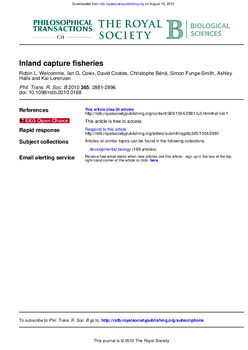Inland capture fisheries

Citation
Welcomme, R.L. et al. (2010). Inland capture fisheries. Philosophical Transactions of the Royal Society B: Biological Sciences 365 (1554): 2881-2896
The reported annual yield from inland capture fisheries in 2008 was over 10 million tonnes, although real catches are probably considerably higher than this. Inland fisheries are extremely complex, and in many cases poorly understood. The numerous water bodies and small rivers are inhabited by a wide range of species and several types of fisher community with diversified livelihood strategies for whom inland fisheries are extremely important. Many drivers affect the fisheries, including internal fisheries management practices. There are also many drivers from outside the fishery that influence the state and functioning of the environment as well as the social and economic framework within which the fishery is pursued. The drivers affecting the various types of inland water, rivers, lakes, reservoirs and wetlands may differ, particularly with regard to ecosystem function. Many of these depend on land-use practices and demand for water which conflict with the sustainability of the fishery. Climate change is also exacerbating many of these factors. The future of inland fisheries varies between continents. In Asia and Africa the resources are very intensely exploited and there is probably little room for expansion; it is here that resources are most at risk. Inland fisheries are less heavily exploited in South and Central America, and in the North and South temperate zones inland fisheries are mostly oriented to recreation rather than food production.
Permalink
Date Available
Type
Publisher
ISSN
0962-8436
Research Themes
Language